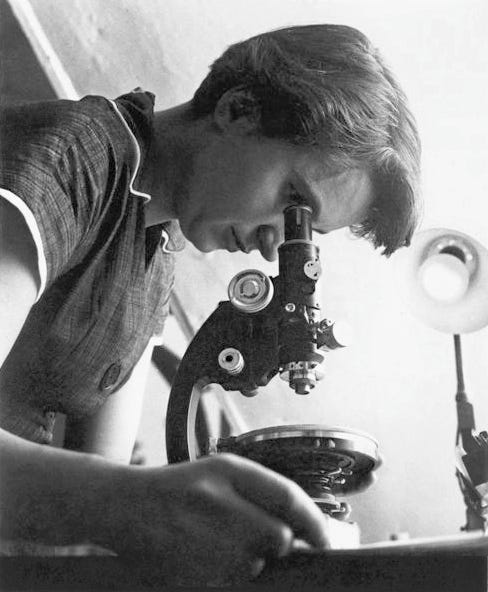#111 - Notes on Wangari Maathai and Rosalind Franklin
Education Coffee is a 2x Weekly Newsletter on People, Ideas and Culture.
Why #LearningStories?
In 2020, I started a podcast called #LearningStories to understand how people acquired a set of skills and knowledge in a creative and innovative manner. In the process I hoped to uncover a new understanding of learning as conceptualized, narrated, and imagined by our guests. I completed #50 episodes and you can find the archives here.
I recently started writing about the #LearningStories of individuals that have inspired me over time. I know I won’t be able to interview them on my podcast but I can research their lives and try my best to paint a portrait of how they learned and built their careers and lives over time. Here is the learning story of two such individuals in the fields of environmental conservatism and scientific research. This a new series I hope to publish and release periodically through this newsletter. You can find other such posts in the archive section of my blog.
Wangari Maathai Learning Story
Wangarĩ Maathai (1940 – 2011) was a Kenyan social, environmental, and political activist who founded the Green Belt Movement, an environmental non-governmental organization focused on the planting of trees, environmental conservation, and women’s rights. In 2004 she became the first African woman to win the Nobel Peace Prize.
Curiosity
She was born in 1940 in the Nyeri District, Kenya. Her father worked on a farm. She started schooling at the age of 8. She studied at St Cecelia’a Intermediate and Primary School and the Loreto High School. She received a scholarship to study in American at the end of high school. It was at university that she first witnessed environmental activism when she saw local environmentalists start a campaign to rid the city of air pollution. Her early exposure on the farm and her studies at university had sown the seeds of a passion for environmentalism from a young age.
Competence
In 1964, she completed a Bachelor of Science Degree in Biology from Benedictine College. In 1966, she completed a Masters of Science Degree in Biology from the University of Pittsburgh in 1966. She then started her doctoral studies and started worked as a research assistant in the Department of Veterinary Anatomy of the University of Nairobi. In 1971, she completed her doctoral studies and became the first East African Woman to receive a Ph.D. Her dissertation was about the development and differentiation of gonads in bovines. In 1977, she was appointed associate professor in the department of veterinary anatomy of University of Nairobi.
Creation
In 1973 she became director of the Kenyan Red Cross Society. At this time she also started working closely with the Environment Liaison Center, the National Council of Women and United Nations Environment Program. This then led to the founding of Envirocare Ltd., a business that involved the planting of trees to conserve the environment involving ordinary people in the process. Since 1977, the Green Belt Movement has led to the planting of 51 million trees and training of over 30000 women. Wangarĩ Maathai was awarded the 2004 Nobel Peace Prize for her “contribution to sustainable development, democracy and peace.”
Notes and Reference
Rosalind Franklin Learning Story
Rosalind Elsie Franklin (1920 – 1958) was a British chemist and X-ray crystallographer whose work was central to the understanding of the molecular structures of DNA (deoxyribonucleic acid), RNA (ribonucleic acid), viruses, coal, and graphite. She clicked Photograph 51 that was a famous X-ray image of DNA that was taken in 1952 at King’s College London that showed the double-helix structure of DNA. This is her learning story.
Curiosity
Franklin was born in Notting Hill, London in 1920. Her father was a merchant banker. Rosalind was the second child in the family of five children. Franklin was 11 when she went to St Paul’s Girls’ School in Hammersmith, west London. This was one of the few girls’ schools in London that taught physics and chemistry. At St Paul’s, she excelled in science, Latin, and sport. Franklin also learned German, and became fluent in French, a language she would later find useful. In 1938 Franklin passed her high school matriculation exams. With six distinctions she got a scholarship for her university education.
Competence
In 1938, Franklin went to Newnham College, Cambridge. She studied chemistry within the Natural Sciences Tripos. In 1941 Franklin graduated with a degree in natural sciences from Newnham College, Cambridge. She then enrolled for a PhD in physical chemistry. She also took up a research position under the British Coal Utilisation Research Association (BCURA) in 1942. The research on coal helped Franklin earn a PhD from Cambridge in 1945. She moved to Paris in 1947 as a chercheur (postdoctoral researcher) under Jacques Mering at the Laboratoire Central des Services Chimiques de l’État. Here she learned important technical skills and became an accomplished X-ray crystallographer.
Creation
In 1950, she started working with John Randall in the biophysics unit at King’s College, London. Here she partnered with a graduate student Raymond Gosling to use X-Ray diffraction techniques to study DNA fibres. After 100 hours of X-Ray exposure she got an important picture of the DNA Fibre known as Photograph 51. In 1953, James Watson and Francis Crick used this photograph and it became the basis of the their famous model of the DNA. They won the Nobel Prize in 1962 for this discovery. Franklin moved to Birkbeck College and continued research on the tobacco mosaic virus and RNA. She published 17 papers on viruses during her time there.
Notes and Reference
Abhishek





